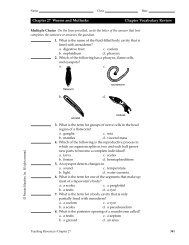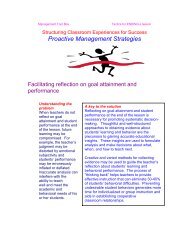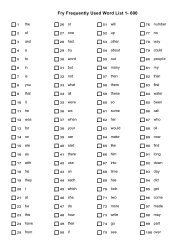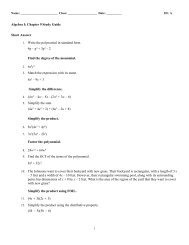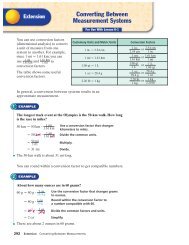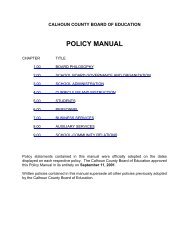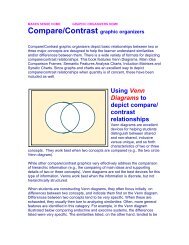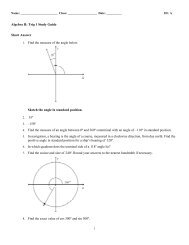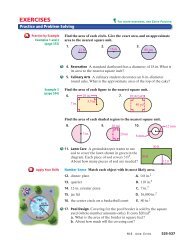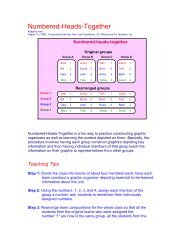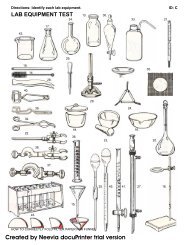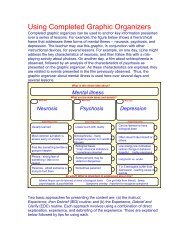Experiment P13: Modified Atwood's Machine (Smart Pulley)
Experiment P13: Modified Atwood's Machine (Smart Pulley)
Experiment P13: Modified Atwood's Machine (Smart Pulley)
You also want an ePaper? Increase the reach of your titles
YUMPU automatically turns print PDFs into web optimized ePapers that Google loves.
<strong>Experiment</strong> <strong>P13</strong>: <strong>Modified</strong> <strong>Atwood's</strong> <strong>Machine</strong><br />
(<strong>Smart</strong> <strong>Pulley</strong>)<br />
Concept: Newton's Second Law Extension Lab Time: 45 min.<br />
PURPOSE: The purpose of this laboratory activity is to study the relationship between force, mass, and<br />
acceleration using a modified <strong>Atwood's</strong> <strong>Machine</strong> apparatus.<br />
EQUIPMENT NEEDED<br />
• Science Workshop Interface • Dynamics cart and track • table clamp, universal<br />
• <strong>Smart</strong> <strong>Pulley</strong> • thread • mass set & hanger<br />
Cart M<br />
<strong>Smart</strong><br />
<strong>Pulley</strong><br />
Clamp<br />
Newton’s Second Law: Acceleration of a Cart (SP)<br />
To interface<br />
Hanging<br />
Mass<br />
m<br />
THEORY: The acceleration of an object depends on the net applied force, and the mass. In a modified <strong>Atwood's</strong> <strong>Machine</strong>, the<br />
the hanging mass determines the net force acting on the system of both masses. This net force accelerates both the hanging<br />
mass and the cart’s mass; the cart mass is accelerated horizontally, and the hanging mass is accelerated downward.<br />
In the free body diagram of the modified Atwood’s machine above,the acceleration of the cart may be calculated using<br />
Newton’s Second Law. The hanging mass (m) attached to the cart by a string and pulley accelerates the cart mass (M). For a<br />
massless and frictionless pulley, the string tension T will be the same throughout the string. Applying Newton’s Second Law<br />
to first the hanging mass and next to the cart yields the following equations:<br />
mg − T = ma<br />
T = Ma<br />
where g is the acceleration due to gravity. If the tension T is eliminated by a simultaneous solution, a final equation for the<br />
acceleration can be obtained:<br />
a =<br />
mg<br />
(m + M)<br />
If the calculated value for the acceleration from Equation (2) matches the measured acceleration, Newton’s Second Law is<br />
verified.<br />
PROCEDURE: For this activity, the <strong>Smart</strong> <strong>Pulley</strong> will measure the motion of both masses as one moves down<br />
and the other moves horizontally. The Science Workshop program calculates the changing speed of the masses as<br />
they move. The slope of a graph of velocity versus time gives the acceleration of the system.<br />
PART I: Computer Setup<br />
1. Connect the Science Workshop interface to the computer, turn on the interface, and turn on the computer.<br />
2. Connect the stereo phone plug of the <strong>Smart</strong> <strong>Pulley</strong> to Digital Channel 1 on the interface.<br />
3. Open the Science Workshop document titled as shown: <strong>P13</strong> <strong>Atwood's</strong> <strong>Machine</strong><br />
•The document opens with a Graph display of Velocity (m/sec) versus Time (sec).<br />
PART II: Equipment Setup<br />
1. Mount a clamp to the end of the track. Place the <strong>Smart</strong> <strong>Pulley</strong> in the clamp so that the <strong>Smart</strong> <strong>Pulley</strong>’s<br />
rod is vertical and the top of the pulley is level with the top of the cart. Install a stop to prevent the cart from<br />
striking the pulley. Level the track.<br />
2. Use a piece of thread about 10 cm longer than the distance from the top of the pulley to the floor.<br />
3. Fasten the thread to the weight hanger and to the cart.<br />
4. Place the amount of mass listed in the data table on the weight hanger and cart.<br />
Don’t forget to account for the mass of the hanger and cart in all calculations at the end.<br />
5. Move the cart until the hanging mass almost touches the pulley. Hold the cart steady to keep it from rolling<br />
and to keep the red photogate light off.<br />
Turn the pulley so that the photogate beam of the <strong>Smart</strong> <strong>Pulley</strong> is unblocked (the red light-emitting diode<br />
(LED) on the photogate does not light).<br />
(2)<br />
Tommy Morgan JSU 1 Adapted from Pasco Lab Manual
PART III: Data Recording<br />
1. Click the "REC" button. Let the cart go. Data recording will begin when the photogate beam of the <strong>Smart</strong><br />
<strong>Pulley</strong> is blocked.<br />
2. Click the "STOP" button to end data recording just before the cart hits the stop.<br />
3. Change the relationship between M and m by removing mass from the cart and adding it to the mass<br />
hanger. Position the amount of mass for each run as listed in the data table.<br />
4. Repeat each run three times then calculate the average experimental acceleration.<br />
NOTE: Add the mass of the weight hanger to the masses listed for hanging mass.<br />
Mass of cart<br />
Part 1. Total Mass Constant [(cart mass M + 120g) + mass hanger]<br />
Net Force Variable<br />
Run<br />
M<br />
grams<br />
1 100 20<br />
2 80 40<br />
3 60 60<br />
4 40 80<br />
5 20 100<br />
6 0 120<br />
m<br />
grams<br />
__________<br />
Mass of mass<br />
hanger<br />
___________<br />
Exp. Acceleration - m/s 2 F net M + m a theory<br />
Trial 1 Trial 2 Trial 3 Average (N) (Kg) (m/s 2 ) % Diff.<br />
Part 2. Net Force Constant [m = 0.060 kg]<br />
Total Mass Variable (Don’t forget the mass hanger)<br />
Run<br />
M<br />
grams<br />
1 0 60<br />
2 300 60<br />
3 600 60<br />
4 900 60<br />
5 1200 60<br />
m<br />
grams<br />
Exp. Acceleration - m/s 2 F net M + m a theory<br />
Trial 1 Trial 2 Trial 3 Average (N) (Kg) (m/s 2 ) % Diff.<br />
REQUIREMENTS<br />
•Use MKS units (Meters, Kilograms, Seconds) for calculations.<br />
1. Calculate the net force for each trial. The net force is the hanging mass times the acceleration of gravity, or<br />
mg.<br />
2. Calculate the total mass for each trial, (M + m). Use the net force and total mass to calculate the theoretical<br />
acceleration using Newton's Second Law: F = ma<br />
QUESTION<br />
1. Compare the experimental acceleration with the theoretical acceleration by determining the percent error.<br />
What are some reasons that would account for the percent error<br />
Prepare a graph of net force(mg) in Newtons versus the experimental acceleration using the Part 1 data.<br />
Prepare a graph of total Mass versus the inverse of the experimental acceleration using the Part 2 data.<br />
Tommy Morgan JSU 2 Adapted from Pasco Lab Manual



